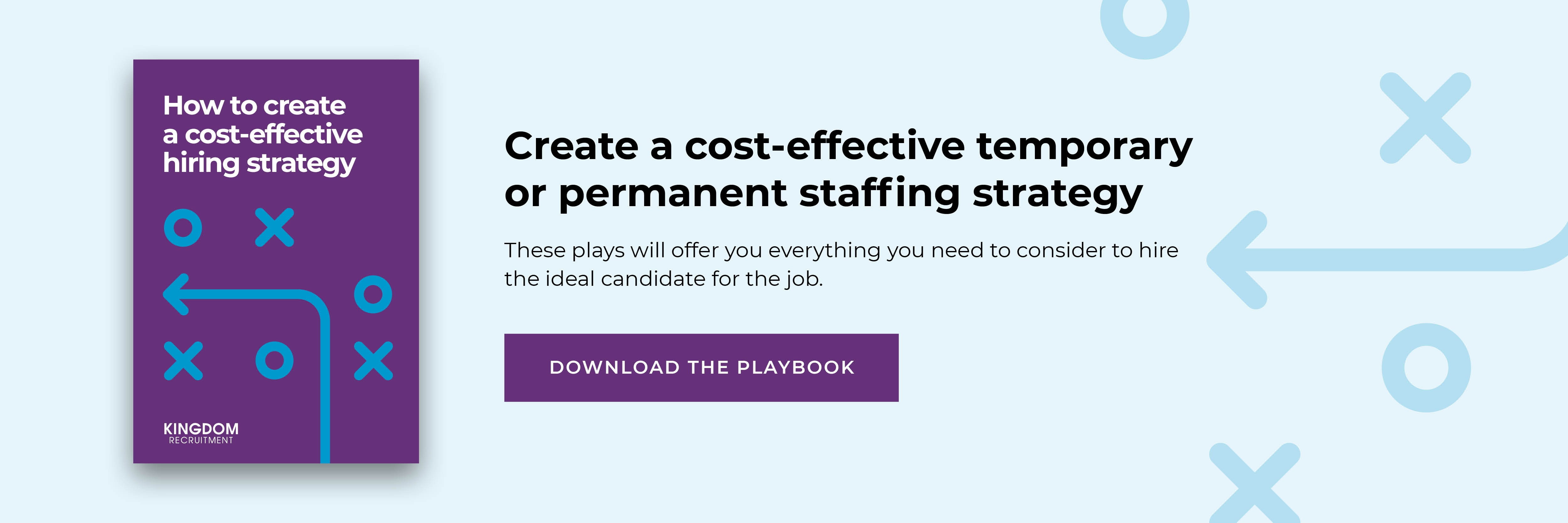The wrong hire costs businesses time and money. It also affects the productivity of the rest of your team as they may need to spend more time doing another person’s work. This is why it’s important to spend time fine-tuning your recruitment process.
.jpeg?width=8213&name=AdobeStock_427849330-1%20(1).jpeg)
To do this successfully, there's a variety of recruiting metrics that are worth tracking. We’re taking a closer look at why tracking recruiting metrics is useful and which ones to track.
Why track metrics?
Tracking performance metrics provide a variety of valuable insights. It’s instrumental in improving future hiring cycles, tracking employee turnover rates and understanding the productivity of a short-term workforce. Ultimately, this will help control costs, such as hiring budget, costs per hire, time spent and hiring velocity.
The best thing to do to track performance metrics is to use a hiring scorecard. A hiring scorecard is a list of skills, traits and qualifications a candidate needs to succeed in a job role. In order to make a scorecard, you need to measure your net hiring score by surveying the hiring manager and hire themselves about how they feel the new hire fits.
Next, subtract the percentage of negative responses from positive responses - the delta is your net hiring score. Finally, take your hiring budget expressed as a percentage of total payroll and your hiring velocity expressed as the percentage of jobs filled on time.
By using these three metrics based on your needs, you’ll experience greater success in high-volume recruiting.
This helps inform and improves future hiring cycles so you know when to hire and use the hiring budget wisely. The metrics you track when volume recruiting will also give you insight into employee turnover rates and help you understand the productivity of your short-term workforce.
Cost per hire (CPH)
Many HR professionals find cost per hire is one of the most helpful HR metrics. Use the formula below to help work out your cost per hire figure.
Cost Per Hire = (External Costs + Internal Costs/Total Number of Hires)
CPH reveals the link between recruitment efforts and cost savings which people easily understand outside of HR. Cost per hire ensures recruiting efforts are right for your business and make sense for your industry, the size of your organisation and where you’re located.
However, it’s important to use this metric against other performance metrics, such as quality of hire and hiring velocity, to ensure you gain a complete picture.
Hiring velocity
The longer it takes to fill a position, the more productivity is disrupted. This is because employees need to spend time covering for the role that needs to be filled. Not only that but the hiring and onboarding process also takes time which may eat into more margins.
If the hiring process is poor, you may even lose top candidates to other competitors. This is why measuring hiring velocity is essential.
Time to fill
Time to fill is another valuable metric to track when volume recruiting. This is all about monitoring how efficient your recruitment process is, as it tracks the number of days between when a job is created and the day a candidate accepts the offers. The aim here is to reduce your time to fill, especially since it can create a competitive recruiting advantage if you offer jobs quicker than your competitors.
Although it’s one of the most important metrics, it’s also one of the easiest to improve. With options like automation, AI, utilising technology, rediscovering previous candidates and outsourcing to recruitment specialists, there are plenty of ways you can reduce your time to fill metric.
Quality of hire
Quality of hire is often measured by someone’s performance rating in the first year. A candidate who is given a high-performance rating indicates hiring success while a candidate with a low-performance rating shows a bad hire.
One bad hire can cost a company thousands in direct and indirect costs. If you combine this with the channel you used to source the candidate, you can also measure the channel quality.
To measure your success ratio, divide the number of hires who perform well by the total number of candidates hired. If you have a high success ratio, it means that most of the candidates you hired performed well. A low ratio means you need to revisit your selection process and fine-tune it.
Improving your hiring process goes beyond tracking metrics. To start on the front foot, you first need to create a cost-effective hiring strategy to determine who you need to hire, how you’ll hire them and how you’ll onboard new starters. That’s where our new guide can help.
How to create a cost-effective hiring strategy
To help you with your hiring strategy, make sure to check out our brand-new playbook- filled with plenty of actionable plays and valuable advice you can use right away. It’s essential to have a strategy to help you save time and money during the recruiting process. To discover everything you need to consider to hire the ideal candidate, click the banner below.

